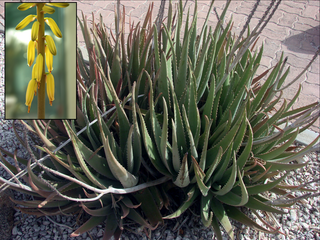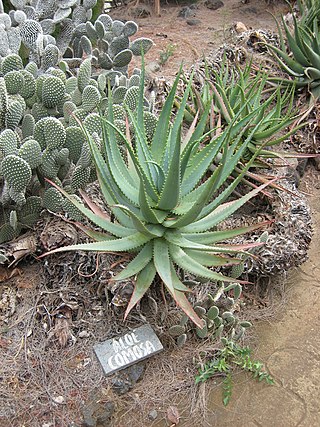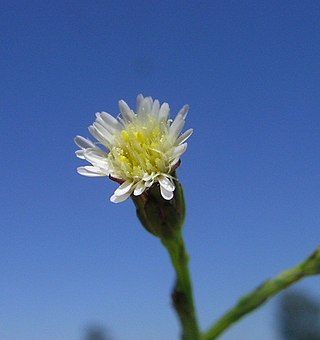
Aloe is a genus containing over 650 species of flowering succulent plants. The most widely known species is Aloe vera, or "true aloe". It is called this because it is cultivated as the standard source for assorted pharmaceutical purposes. Other species, such as Aloe ferox, are also cultivated or harvested from the wild for similar applications.

Aloe vera is a succulent plant species of the genus Aloe. It is widely distributed, and is considered an invasive species in many world regions.
Melhania milleri is listed in the 2004 IUCN Red List as a species of flowering plant in the family Malvaceae, endemic to Socotra, with its natural habitats being subtropical or tropical dry forests and subtropical or tropical dry shrubland. As of March 2023, the species was not listed by the International Plant Names Index, nor by other taxonomic databases such as Plants of the World Online.
Pluchea glutinosa was a species of flowering plant in the sunflower family that was endemic to the Island of Socotra in the Indian Ocean, part of the Republic of Yemen.

Hypericum scopulorum is a species of flowering plant in the family Hypericaceae. It is endemic to Socotra, an island archipelago that is part of Yemen. It is a common plant in shrubland habitat, and it is a dominant species in some areas along with Cephalocroton and another local endemic, Libinhania rosulata.

Aloe comosa is a species of flowering plant in the Asphodelaceae family. It is commonly called Clanwilliam aloe) and is endemic to South Africa.

Aloe perryi is a species of plant in the genus Aloe. It is endemic to the island of Socotra in Yemen, and may be known by the common name, Socotrine aloe.

Aloe squarrosa is a species of flowering plant in the Asphodelaceae family. It is from the island of Socotra, Yemen.
Aloe viridiflora is a species of plant in the genus Aloe. The species is endemic to Namibia with a wide range and is known from at least six different populations. Current trends are not known and the species is listed as LC on the IUCN Red List. However, it is scarce and Namibian authorities consider it threatened; the plant must not be removed or disturbed. It is the only known green-flowering aloe. Its natural habitats are dry savanna, subtropical or tropical dry shrubland, and rocky areas. It can produce hallucinations when ingested, leading to its occasional use in shamanic rituals.
Dirichletia obovata, synonym Carphalea obovata, is a species of plant in the family Rubiaceae. It is endemic to Socotra. Its natural habitat is subtropical or tropical dry forests.

Exacum affine, known commercially as the Persian violet, is a species of plant in the family Gentianaceae. It is endemic to Socotra, part of Yemen, though its popularity and cultivation around the world have made it an occasional greenhouse weed. Its natural habitat is rocky areas. This is a small herbaceous biennial plant with dark green, ovate leaves. The small purple flowers have a yellow centre with fragrance.

Aloiampelos commixta is a flowering plant in the Asphodelaceae family. It is commonly called Table Mountain aloe, and is a rare succulent plant that is endemic to the Cape Peninsula, South Africa. It naturally occurs only on the Table Mountain range, within the city of Cape Town.

Senna sophera is a shrub or tree in the bean family Fabaceae. It is now widespread in tropical and subtropical regions of the world, but is believed to be native to tropical America. Originally described by Carl Linnaeus in 1753 as Cassia sophera, it has acquired a large number of synonyms. Vernacular names include algarrobilla, baner, kasunda, kasaundi (Hindi) and kolkasunda (Bengali).

Dorstenia gigas is a species of flowering plant in the Moraceae family. It is a succulent native to the Socotra Islands off the Horn of Africa.

Acer heldreichii is a species of maple in the flowering plant family Sapindaceae. Commonly called Balkan maple, Greek maple, Heldreich's maple, or mountain maple the species is native to the Balkan Peninsula east along the southern and eastern coasts of the Black Sea.

Aloe buettneri is a species of succulent plant in the family Asphodelaceae. It is found in West Africa and is known for its medicinal uses.

Aloe littoralis is a flowering plant in the Asphodelaceae family. It is a succulent native to arid regions in South Tropical Africa and Southern Africa.

Aloe rupestris is an arborescent aloe indigenous to summer-rainfall areas of southern Africa.

Symphyotrichum subulatum, commonly known as eastern annual saltmarsh aster or, in Britain and Ireland where it is naturalized, annual saltmarsh aster, is an annual plant in the family Asteraceae native to the eastern United States and the Gulf Coast to Texas. The species grows primarily in coastal salt marshes, although in the Ozarks it occurs as a non-marine weedy variety.
Stephanotis arabica, synonyms including Dregea arabica and Marsdenia robusta, is a species of flowering plant in the family Apocynaceae, native to Socotra and mainland Yemen. It was first described by Joseph Decaisne in 1844.















